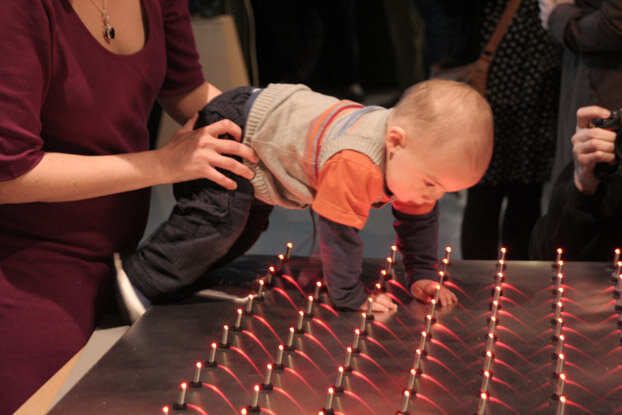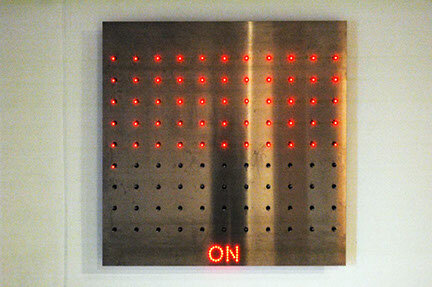ON/OFF, 2009
FACT Liverpool Switch and Meter: External architectural projections.
Images by Karen Fraser
SOUSVEILLANCE
Ubiquitous Research by Glenn Davidson for Radiator.
The ON/OFF button (mechanical and electrical), the use, attractiveness, the effect they have. My research looks at one of the route causes of global warming – the ON/OFF button.
Through the research I will look at three parts of this subject, the button in its self, the relationship with the human body and finally what relationship the button has to the “effect” it has or ‘what the button does. It should be noted that ON/OFF buttons can come just by them selves and as such they are relatively harmless.
However this research will focus on ON/OFF buttons which are connected to apparatus and through which the combination of their operation as either ON or OFF has some form of “effect” in the world.
Note: Kraftwerk, the 80s German popular music electrical band, epitomise where ON/OFF button research can lead, and the effect it can have on society. And it does not stop there!. These days everyone appears to be using buttons, kids, the elderly, and those in the middle. Buttons are now a big part of our lives. At this stage one could ask, “are they (the ON/OFF buttons) running us?
Our cities appear to be organised through button pushing, and it has to be said quite a bit of paper pushing and hot air too,…that is beyond our research also. And in the process the ON/OFF button appears to be ruining our planet !? but this ….unfortunately lies well beyond our research too.
In attempting to understand more about the attraction of the ON/OFF button we need to look closer at what is out there. What sort of buttons exist, what colours and forms there are, what sizes, and if function follows form.
OUTSIDE BUTTONS
Here I am on the street. There are ON/OFF buttons of many kinds here, on doors, lifts, in walls on ATMs, pedestrian crossings, on cars, bikes and of many different kinds. Now you see what I mean about buttons, there are thousands of them!.. but unfortunately I have tricked you a little. Most of these are in fact not ON/OFF buttons, these are ON buttons which return to OFF position automatically rather than manually, so, I am afraid, these too are beyond our research.
So we need to limit our research to those ON/OFF buttons which we are supposedly in control of; those with both pole positions of ON and the OFF that may be made so through the action of a person. Indeed it must be said that as this writer thinks about it, some ON/OFF buttons have automatic functions nesting within a manual ON/OFF functionality, so we must be vigilant and establish the strictest boundaries around our research, such that we are not swamped by opportunities.
Broadly speaking we expect this research is to focus on ON/OFF buttons that are sold on goods we don’t need, bought with money we are enthused to spend, but never have enough of and sold with instructions we don’t read…(another subject well beyond our research !) And another point, if you are lucky enough to press a button and get an “effect”, and you own that effect, generally speaking you pay! The ensuing “effect” of turning ON is expensive, (and this too is way beyond our research.)
Obviously the ON/OFF buttons will need documenting and classifying in order to highlight their impact upon us.
Concern about ON/OFF button use extends to broken fingernails, false handling, the danger of pushing rather than flicking and all that cybernetic “man machine interface stuff”.
Then there is the use its self, what the button actually says about the effect it has, is there a connection or not?, does the button make you feel good etc ? This will be an aspect of data collected and represents “filling” – so called qualitative data that is un provable except if other ON/OFF researchers observations agree with our findings.












The two Switch Board works were commissioned by Radiator Festival in Feb 2009 seen above the switch works in Surface Gallery, Nottingham exhibited again in the Guest Performance Lecture for Climate for Change at FACT private view where audience explored.



